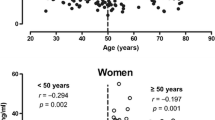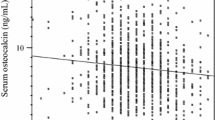Abstract
Purpose
Diabetic osteopathy is an upcoming complication of diabetes characterized by osteoporosis, increased risk for bone fractures and alterations in bone metabolism. Osteocalcin (OC) is a bone-specific protein produced by osteoblasts involved in the regulation of glucose and energy metabolism. The aim of this study is to determine whether OC serum levels are correlated with metabolic control in adult subjects with type one diabetes mellitus (T1DM).
Methods
A cross-sectional study was conducted on 93 subjects (51 men) with mean age, disease duration and body mass index (BMI) of 39.9 ± 12.3, 17.2 ± 12.6 years and 24.5 ± 3.4 kg/m2, respectively. Blood samples were drawn to measure levels of hemoglobin A1c (HbA1c), OC, 25-OH vitamin D and PTH.
Results
Significant inverse correlations were found between OC and HbA1c (r = −0.295, P = 0.004) and between OC and BMI (r = −0.218, P = 0.037). These correlations were confirmed also among men in the analyses by gender [HbA1c vs OC: r = −0.363, P = 0.009; BMI vs OC: r = −0.291, P = 0.043], and similar but nonsignificant trends were confirmed among women. A significant difference in mean OC was also found between the lowest and the highest HbA1c tertile (22.3 ± 10.0 vs 16.9 ± 8.0 ng/mL, P = 0.025).
Conclusions
These data show that in T1DM of long duration, OC serum levels are inversely associated with HbA1c and BMI, supporting the hypothesis that a poor glycemic control can affect osteoblast function.



Similar content being viewed by others
References
International Diabetes Federation Guidelines (2011) Diabetes in childhood and adolescence
Gunczler P, Lanes R, Paz-Martinez V et al (1998) Decreased lumbar spine bone mass and low bone turnover in children and adolescents with insulin dependent diabetes mellitus followed longitudinally. J Pediatr Endocrinol Metab 11:413–419
Hoang QQ, Sicheri F, Howard AJ, Yang DSC (2003) Bone recognition mechanism of porcine osteocalcin from crystal structure. Nature 425:977–980. doi:10.1038/nature02079
Dowd TL, Rosen JF, Li L, Gundberg CM (2003) The three-dimensional structure of bovine calcium ion-bound osteocalcin using 1H NMR spectroscopy. Biochemistry 42:7769–7779. doi:10.1021/bi034470s
Hauschka PV, Carr SA (1982) Calcium-dependent alpha-helical structure in osteocalcin. Biochemistry 21:2538–2547
Ferron M, Hinoi E, Karsenty G, Ducy P (2008) Osteocalcin differentially regulates beta cell and adipocyte gene expression and affects the development of metabolic diseases in wild-type mice. Proc Natl Acad Sci USA 105:5266–5270. doi:10.1073/pnas.0711119105
Lee NK, Sowa H, Hinoi E et al (2007) Endocrine regulation of energy metabolism by the skeleton. Cell 130:456–469. doi:10.1016/j.cell.2007.05.047
Kindblom JM, Ohlsson C, Ljunggren O et al (2009) Plasma osteocalcin is inversely related to fat mass and plasma glucose in elderly Swedish men. J Bone Miner Res 24:785–791. doi:10.1359/jbmr.081234
Lee YJ, Lee H, Jee SH et al (2010) Serum osteocalcin is inversely associated with adipocyte-specific fatty acid-binding protein in the Korean metabolic syndrome research initiatives. Diabetes Care 33:e90. doi:10.2337/dc10-0071
Pittas AG, Harris SS, Eliades M et al (2009) Association between serum osteocalcin and markers of metabolic phenotype. J Clin Endocrinol Metab 94:827–832. doi:10.1210/jc.2008-1422
Saleem U, Mosley TH, Kullo IJ (2010) Serum osteocalcin is associated with measures of insulin resistance, adipokine levels, and the presence of metabolic syndrome. Arterioscler Thromb Vasc Biol 30:1474–1478. doi:10.1161/ATVBAHA.110.204859
Hwang Y-C, Jeong I-K, Ahn KJ, Chung HY (2009) The uncarboxylated form of osteocalcin is associated with improved glucose tolerance and enhanced beta-cell function in middle-aged male subjects. Diabetes Metab Res Rev 25:768–772. doi:10.1002/dmrr.1045
Kanazawa I, Yamaguchi T, Yamamoto M et al (2009) Serum osteocalcin level is associated with glucose metabolism and atherosclerosis parameters in type 2 diabetes mellitus. J Clin Endocrinol Metab 94:45–49. doi:10.1210/jc.2008-1455
Im J-A, Yu B-P, Jeon JY, Kim S-H (2008) Relationship between osteocalcin and glucose metabolism in postmenopausal women. Clin Chim Acta 396:66–69. doi:10.1016/j.cca.2008.07.001
Bao Y-Q, Zhou M, Zhou J et al (2011) Relationship between serum osteocalcin and glycaemic variability in type 2 diabetes. Clin Exp Pharmacol Physiol 38:50–54. doi:10.1111/j.1440-1681.2010.05463.x
Prats-Puig A, Mas-Parareda M, Riera-Pérez E et al (2010) Carboxylation of osteocalcin affects its association with metabolic parameters in healthy children. Diabetes Care 33:661–663. doi:10.2337/dc09-1837
Pollock NK, Bernard PJ, Wenger K et al (2010) Lower bone mass in prepubertal overweight children with prediabetes. J Bone Miner Res 25:2760–2769. doi:10.1002/jbmr.184
Maggio ABR, Ferrari S, Kraenzlin M et al (2010) Decreased bone turnover in children and adolescents with well controlled type 1 diabetes. J Pediatr Endocrinol Metab 23:697–707
Pater A, Sypniewska G, Pilecki O (2010) Biochemical markers of bone cell activity in children with type 1 diabetes mellitus. J Pediatr Endocrinol Metab 23:81–86
Thrailkill KM, Jo C-H, Cockrell GE et al (2012) Determinants of undercarboxylated and carboxylated osteocalcin concentrations in type 1 diabetes. Osteoporos Int 23:1799–1806. doi:10.1007/s00198-011-1807-7
Napoli N, Strollo R, Pitocco D et al (2013) Effect of calcitriol on bone turnover and osteocalcin in recent-onset type 1 diabetes. PLoS One 8:e56488. doi:10.1371/journal.pone.0056488
Motyl KJ, McCabe LR, Schwartz AV (2010) Bone and glucose metabolism: a two-way street. Arch Biochem Biophys 503:2–10. doi:10.1016/j.abb.2010.07.030
Hofbauer LC, Brueck CC, Singh SK, Dobnig H (2007) Osteoporosis in patients with diabetes mellitus. J Bone Miner Res 22:1317–1328. doi:10.1359/jbmr.070510
Ma L, Oei L, Jiang L et al (2012) Association between bone mineral density and type 2 diabetes mellitus: a meta-analysis of observational studies. Eur J Epidemiol 27:319–332. doi:10.1007/s10654-012-9674-x
Melton LJ, Riggs BL, Leibson CL et al (2008) A bone structural basis for fracture risk in diabetes. J Clin Endocrinol Metab 93:4804–4809. doi:10.1210/jc.2008-0639
Burghardt AJ, Issever AS, Schwartz AV et al (2010) High-resolution peripheral quantitative computed tomographic imaging of cortical and trabecular bone microarchitecture in patients with type 2 diabetes mellitus. J Clin Endocrinol Metab 95:5045–5055. doi:10.1210/jc.2010-0226
Hadjidakis DJ, Raptis AE, Sfakianakis M et al (2006) Bone mineral density of both genders in type 1 diabetes according to bone composition. J Diabetes Complicat 20:302–307. doi:10.1016/j.jdiacomp.2005.07.006
McCabe LR (2007) Understanding the pathology and mechanisms of type I diabetic bone loss. J Cell Biochem 102:1343–1357. doi:10.1002/jcb.21573
Goh S-Y, Cooper ME (2008) Clinical review: the role of advanced glycation end products in progression and complications of diabetes. J Clin Endocrinol Metab 93:1143–1152. doi:10.1210/jc.2007-1817
Räkel A, Sheehy O, Rahme E, LeLorier J (2008) Osteoporosis among patients with type 1 and type 2 diabetes. Diabetes Metab 34:193–205. doi:10.1016/j.diabet.2007.10.008
Conover CA, Lee PD, Riggs BL, Powell DR (1996) Insulin-like growth factor-binding protein-1 expression in cultured human bone cells: regulation by insulin and glucocorticoid. Endocrinology 137:3295–3301
Thrailkill KM, Lumpkin CK, Bunn RC et al (2005) Is insulin an anabolic agent in bone? Dissecting the diabetic bone for clues. Am J Physiol Endocrinol Metab 289:E735–E745. doi:10.1152/ajpendo.00159.2005
Pozzilli P, Manfrini S, Crinò A et al (2005) Low levels of 25-hydroxyvitamin D3 and 1,25-dihydroxyvitamin D3 in patients with newly diagnosed type 1 diabetes. Horm Metab Res 37:680–683. doi:10.1055/s-2005-870578
Pitocco D, Crinò A, Di Stasio E et al (2006) The effects of calcitriol and nicotinamide on residual pancreatic beta-cell function in patients with recent-onset type 1 diabetes (IMDIAB XI). Diabet Med 23:920–923. doi:10.1111/j.1464-5491.2006.01921.x
Bizzarri C, Pitocco D, Napoli N et al (2010) No protective effect of calcitriol on beta-cell function in recent-onset type 1 diabetes: the IMDIAB XIII trial. Diabetes Care 33:1962–1963. doi:10.2337/dc10-0814
Kanazawa I, Yamaguchi T, Yamauchi M et al (2011) Serum undercarboxylated osteocalcin was inversely associated with plasma glucose level and fat mass in type 2 diabetes mellitus. Osteoporos Int 22:187–194. doi:10.1007/s00198-010-1184-7
Iki M, Tamaki J, Fujita Y et al (2012) Serum undercarboxylated osteocalcin levels are inversely associated with glycemic status and insulin resistance in an elderly Japanese male population: Fujiwara-kyo osteoporosis risk in men (FORMEN) study. Osteoporos Int 23:761–770. doi:10.1007/s00198-011-1600-7
Ducy P (2011) The role of osteocalcin in the endocrine cross-talk between bone remodelling and energy metabolism. Diabetologia 54:1291–1297. doi:10.1007/s00125-011-2155-z
Gerdhem P, Isaksson A, Akesson K, Obrant KJ (2005) Increased bone density and decreased bone turnover, but no evident alteration of fracture susceptibility in elderly women with diabetes mellitus. Osteoporos Int 16:1506–1512. doi:10.1007/s00198-005-1877-5
Chillaro JJ, Goday A, Flores-le-roux JA et al (2009) Estimated glucose disposal rate in assessment of the metabolic syndrome and microvascular complications in patients with type 1 diabetes. J Clin Endocrinol Metab 94:3530–3534. doi:10.1210/jc.2009-0960
Ferron M, Wei J, Yoshizawa T et al (2010) An ELISA-based method to quantify osteocalcin carboxylation in mice. Biochem Biophys Res Commun 397:691–696. doi:10.1016/j.bbrc.2010.06.008
Ferron M, Wei J, Yoshizawa T et al (2010) Insulin signaling in osteoblasts integrates bone remodeling and energy metabolism. Cell 142:296–308. doi:10.1016/j.cell.2010.06.003
Acknowledgments
This study was supported by a grant from the Italian Ministry of University and Technological research (Prin project of national interest).
Conflict of interest
All the authors declare no conflict of interest.
Author information
Authors and Affiliations
Corresponding author
Rights and permissions
About this article
Cite this article
Maddaloni, E., D’Onofrio, L., Lauria, A. et al. Osteocalcin levels are inversely associated with Hba1c and BMI in adult subjects with long-standing type 1 diabetes. J Endocrinol Invest 37, 661–666 (2014). https://doi.org/10.1007/s40618-014-0092-7
Received:
Accepted:
Published:
Issue Date:
DOI: https://doi.org/10.1007/s40618-014-0092-7




